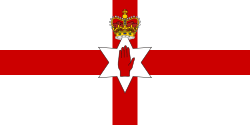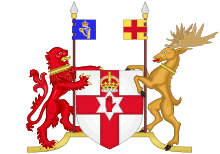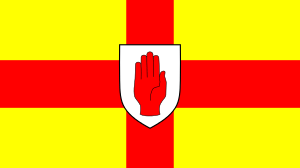Ulster Banner

The Ulster Banner[1] was the flag of the Government of Northern Ireland, and de facto flag of Northern Ireland, from 1953 to 1972. It was based on its earlier coat of arms. The Northern Ireland Government was abolished in 1972 and, since then, the flag has had no official standing. It has become a symbol of Ulster loyalism[2] and a contentious symbol,[3] and is not permitted to be flown from government buildings.[4] It is still used to represent the people of Northern Ireland within the United Kingdom and still recognised by world governing bodies for teams and sportsmen from Northern Ireland.
Origin


The flag is a heraldic banner taken from the coat of arms of Northern Ireland, which were granted in 1924. This is based on the flag of England[5][6] and the flag of Ulster,[7] with the addition of a crown to represent the monarchy of the United Kingdom. As with the flag of Ulster it contains the Red Hand of Ulster at the centre. Rather than a shield, the Red Hand is inside a six pointed star, representing the six counties that make up Northern Ireland.
The flag is also sometimes called the (former) Northern Ireland flag, the (old) Stormont flag, the Ulster flag,[8] or the Red Hand of Ulster flag.[9] Loyalists often use 'Ulster' as another name for Northern Ireland, and Stormont was the seat of Northern Ireland's Government.
History
Use by the Government of Northern Ireland
In 1924, the Government of Northern Ireland was granted its own coat of arms by Royal Warrant and had the right to display these arms on a flag or banner. This right was exercised for the Coronation of Queen Elizabeth II in 1953. From 1953 until 1972, the flag was used officially by the Government of Northern Ireland and also as a de facto civic flag for Northern Ireland. In 1972, the Government and Parliament of Northern Ireland were abolished by the Parliament of the United Kingdom under the Northern Ireland Constitution Act 1973.
Later use
Since the Government of Northern Ireland was abolished in 1972, the flag (and variations thereof) has continued to be used by loyalists and unionists. In 2004, Belfast City Council commissioned a study on the flying of flags which noted that the Ulster Banner continued to be flown, alongside the Union flag, by a number of local authorities in Northern Ireland. These include Ards Borough Council, Carrickfergus Borough Council and Castlereagh Borough Council.[10]
It is also used to represent Northern Ireland at the Commonwealth Games[11][12] and by FIFA to represent the Northern Ireland national football team.[13]
See also
- List of flags of the United Kingdom
- List of flags used in Northern Ireland
- List of flags of the Republic of Ireland
References
- ↑ Groom, Nick (2006). The Union Jack: the Story of the British Flag. Atlantic Books. p. 295. ISBN 978-1-84354-336-7.
- ↑ Flags used in Northern Ireland – CAIN Web Service (quote: "this particular flag of Northern Ireland is seen as staunchly Loyalist")
- ↑ Promoting Fair Play in Sport. Sport Northern Ireland. p.9
- ↑ The Flags Regulations (Northern Ireland) 2000
- ↑ Northern Ireland (United Kingdom) at Flags of the World
- ↑ CAIN: Symbols – Flags Used in Northern Ireland
- ↑ Northern Ireland (United Kingdom)
- ↑ Lords Hansard text for 13 Jul 200613 July 2006 (pt 0947)
- ↑ http://www.limavady.gov.uk/filestore/documents/good_relations/Web_Questionnaire.pdf
- ↑ http://www.belfastcity.gov.uk/equality/docs/FlyingOfUnionFlagEQIA.pdf
- ↑ Commonwealth Games Federation
- ↑ Telegraph
- ↑ Northern Ireland: Country information, FIFA.com
| ||||||||||||||||||||||
